自考英语国家概况-复习资料-课文要点课文要点
- 格式:doc
- 大小:37.00 KB
- 文档页数:9
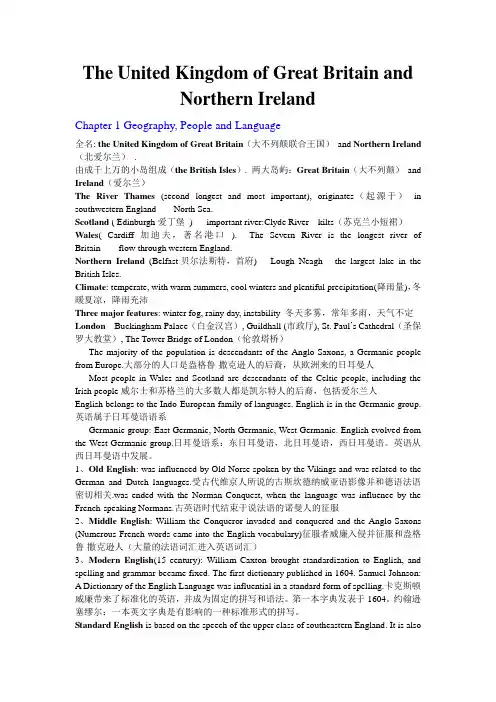
The United Kingdom of Great Britain andNorthern IrelandChapter 1 Geography, People and Language全名: the United Kingdom of Great Britain(大不列颠联合王国)and Northern Ireland (北爱尔兰).由成千上万的小岛组成(the British Isles). 两大岛屿:Great Britain(大不列颠)and Ireland(爱尔兰)The River Thames(second longest and most important), originates(起源于)in southwestern England -----North Sea.Scotland ( Edinburgh爱丁堡) important river:Clyde River kilts(苏克兰小短裙)Wales( Cardiff加迪夫,著名港口). The Severn River is the longest river of Britain------flow through western England.Northern Ireland(Belfast贝尔法斯特,首府) Lough Neagh----the largest lake in the British Isles.Climate: temperate, with warm summers, cool winters and plentiful precipitation(降雨量),冬暖夏凉,降雨充沛Three major features: winter fog, rainy day, instability 冬天多雾,常年多雨,天气不定London---Buckingham Palace(白金汉宫), Guildhall (市政厅), St. Paul’s Cathedral(圣保罗大教堂), The Tower Bridge of London(伦敦塔桥)The majority of the population is descendants of the Anglo-Saxons, a Germanic people from Europe.大部分的人口是盎格鲁-撒克逊人的后裔,从欧洲来的日耳曼人Most people in Wales and Scotland are descendants of the Celtic people, including the Irish people威尔士和苏格兰的大多数人都是凯尔特人的后裔,包括爱尔兰人English belongs to the Indo-European family of languages. English is in the Germanic group.英语属于日耳曼语语系Germanic group: East Germanic, North Germanic, West Germanic. English evolved from the West Germanic group.日耳曼语系:东日耳曼语,北日耳曼语,西日耳曼语。
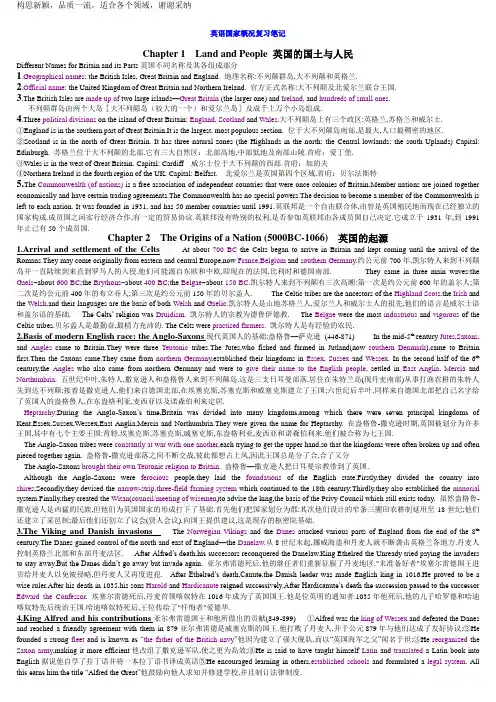
英语国家概况复习笔记Chapter 1 Land and People 英国的国土与人民Different Names for Britain and its Parts英国不同名称及其各组成部分1.Geographical names: the British Isles, Great Britain and England. 地理名称:不列颠群岛,大不列颠和英格兰.2.Official name: the United Kingdom of Great Britain and Northern Ireland. 官方正式名称:大不列颠及北爱尔兰联合王国.3.The British Isles are made up of two large islands—Great Britain (the larger one) and Ireland, and hundreds of small ones.不列颠群岛由两个大岛[大不列颠岛(较大的一个)和爱尔兰岛]及成千上万个小岛组成.4.Three political divisions on the island of Great Britain: England, Scotland and Wales.大不列颠岛上有三个政区:英格兰,苏格兰和威尔士.①England is in the southern part of Great Britain.It is the largest, most populous section. 位于大不列颠岛南部,是最大,人口最稠密的地区.②Scotland is in the north of Great Britain. It has three natural zones (the Highlands in the north; the Central lowlands; the south Uplands) Capital: Edinburgh. 苏格兰位于大不列颠的北部.它有三大自然区:北部高地,中部低地及南部山陵.首府:爱丁堡.③Wales is in the west of Great Britain. Capital: Cardiff 威尔士位于大不列颠的西部.首府:加的夫④Northern Ireland is the fourth region of the UK. Capital: Belfast. 北爱尔兰是英国第四个区域.首府:贝尔法斯特5.The Commonwealth (of nations) is a free association of independent countries that were once colonies of Britain.Member nations are joined together economically and have certain trading agreements.The Commonwealth has no special powers.The decision to become a member of the Commonwealth is left to each nation. It was founded in 1931, and has 50 member countries until 1991.英联邦是一个自由联合体,由曾是英国殖民地而现在已经独立的国家构成.成员国之间实行经济合作,有一定的贸易协议.英联邦没有特别的权利,是否参加英联邦由各成员国自己决定.它成立于1931年,到1991年止已有50个成员国.Chapter 2 The Origins of a Nation (5000BC-1066) 英国的起源1.Arrival and settlement of the Celts At about 700 BC the Celts began to arrive in Britain and kept coming until the arrival of the Romans.They may come originally from eastern and central Europe,now France,Belgium and southern Germany.约公元前700年,凯尔特人来到不列颠岛并一直陆续到来直到罗马人的入侵.他们可能源自东欧和中欧,即现在的法国,比利时和德国南部. They came in three main waves:the Gaels~about 600 BC;the Brythons~about 400 BC;the Belgae~about 150 BC.凯尔特人来到不列颠有三次高潮:第一次是约公元前600年的盖尔人;第二次是约公元前400年的布立吞人;第三次是约公元前150年的贝尔盖人. The Celtic tribes are the ancestors of the Highland Scots,the Irish and the Welsh,and their languages are the basis of both Welsh and Gaelic.凯尔特人是山地苏格兰人,爱尔兰人和威尔士人的祖先,他们的语言是威尔士语和盖尔语的基础. The Celts’ religion was Druidism. 凯尔特人的宗教为德鲁伊德教. The Belgae were the most industrious and vigorous of the Celtic tribes.贝尔盖人是最勤奋,最精力充沛的. The Celts were practised farmers. 凯尔特人是有经验的农民.2.Basis of modern English race: the Anglo-Saxons现代英国人的基础:盎格鲁—萨克逊(446-871) In the mid-5th century Jutes,Saxons, and Angles came to Britain.They were three Teutonic tribes.The Jutes,who fished and farmed in Jutland(now southern Denmark),came to Britain first.Then the Saxons came.They came from northern Germany,established their kingdoms in Essex, Sussex and Wessex. In the second half of the 6th century,the Angles who also came from northern Germany and were to give their name to the English people, settled in East Anglia, Mercia and Northumbria. 五世纪中叶,朱特人,撒克逊人和盎格鲁人来到不列颠岛.这是三支日耳曼部落.居住在朱特兰岛(现丹麦南部)从事打渔农耕的朱特人先到达不列颠;接着是撒克逊人,他们来自德国北部,在埃塞克斯,苏塞克斯和威塞克斯建立了王国;六世纪后半叶,同样来自德国北部把自己名字给了英国人的盎格鲁人,在东盎格利亚,麦西亚以及诺森伯利来定居.Heptarchy:During the Anglo-Saxon’s time,Britain was divided into many kingdoms,among which there were seven principal kingdoms of Kent,Essex,Sussex,Wessex,East Anglia,Mercia and Northumbria.They were given the name for Heptarchy. 在盎格鲁-撒克逊时期,英国被划分为许多王国,其中有七个主要王国:肯特,埃塞克斯,苏塞克斯,威塞克斯,东盎格利亚,麦西亚和诺森伯利来.他们被合称为七王国.The Anglo-Saxon tribes were constantly at war with one another,each trying to get the upper hand,so that the kingdoms were often broken up and often pieced together again. 盎格鲁-撒克逊部落之间不断交战,彼此都想占上风,因此王国总是分了合,合了又分The Anglo-Saxons brought their own Teutonic religion to Britain. 盎格鲁—撒克逊人把日耳曼宗教带到了英国.Although the Anglo-Saxons were ferocious people,they laid the foundations of the English state.Firstly,they divided the country into shires;Secondly,they devised the narrow-strip,three-field farming system which continued to the 18th century;Thirdly,they also established the manorial system.Finally,they created the Witan(council/meeting of wisemen)to advise the king,the basis of the Privy Council which still exists today. 虽然盎格鲁-撒克逊人是凶猛的民族,但他们为英国国家的形成打下了基础.首先他们把国家划分为郡;其次他们设计的窄条三圃田农耕制延用至18世纪;他们还建立了采邑制;最后他们还创立了议会(贤人会议),向国王提供建议,这是现存的枢密院基础.3.The Viking and Danish invasions The Norwegian Vikings and the Danes attacked various parts of England from the end of the 8th century.The Danes gained control of the north and east of England—the Danelaw.从8世纪末起,挪威海盗和丹麦人就不断袭击英格兰各地方.丹麦人控制英格兰北部和东部丹麦法区. After Alfred’s death,his s uccessors reconquered the Danelaw.King Ethelred the Unready tried paying the invaders to stay away.But the Danes didn’t go away but invade again. 亚尔弗雷德死后,他的继任者们重新征服了丹麦地区."未准备好者"埃塞尔雷德国王进贡给丹麦人以免被侵略,但丹麦人又再度进犯. After Ethelred’s death,Canute,the Danish leader was made English king in 1016.He proved to be a wise ruler.After his death in 1035,his sons Harold and Hardicanute reigned successively.After Hardicanute’s death the succession passed to the successor Edward the Confessor. 埃塞尔雷德死后,丹麦首领喀奴特在1016年成为了英国国王.他是位英明的通知者.1035年他死后,他的儿子哈罗德和哈迪喀奴特先后统治王国.哈迪喀奴特死后,王位传给了"忏悔者"爱德华.4.King Alfred and his contributions亚尔弗雷德国王和他所做出的贡献(849-899) ①Alfred was the king of Wessex and defeated the Danes and reached a friendly agreement with them in 879亚尔弗雷德是威塞克斯的国王.他打败了丹麦人,并于公元879年与他们达成了友好协议;②He founded a strong fleet and is known as “the father of the British navy”他因为建立了强大舰队,而以“英国海军之父”闻名于世;③He reorganized the Saxon army,making it more efficient他改组了撒克逊军队,使之更为高效;④He is said to have taught himself Latin and translated a Latin book into English据说他自学了拉丁语并将一本拉丁语书译成英语⑤He encouraged learning in others,established schools and formulated a legal system. All this earns him the title “Alfred the Great”他鼓励向他人求知并修建学校,并且制订法律制度.5.The Norman Conquest and its consequences诺曼征服及其影响(1066) It was said that king Edward had promised the English throne to William, but the Witan chose Harold as king. So William led his army to invade England. In October 1066, William defeated Harold in the battle of Hastings.On Christmas Day William was crowned king of England in Westminster Abbey. 爱德华国王曾答应把英格兰王位传给诺曼底公爵威廉,但是贤人会议挑选了哈罗德为国王.公元1066年10月,在哈斯丁斯战役中威廉打败了哈罗德军队.圣诞节这天在威斯敏斯特大教堂,威廉被加冕为英格兰国王. The Norman Conquest of 1066 is perhaps the best-known event in English history. William the Conqueror confiscated almost all the land and gave it to his Norman followers. He replaced the weak Saxon rule with a strong Norman government.The Norman Conquest ended the English history of being invaded, the feudal system was completely established in England . Relations with the Continent were opened, and civilization and commerce were extended. Norman-French culture, language, manners and architecture were introduced.The Church was brought into closer connection with Rome, and the church courts were separated from the civil courts. 公元1066年的诺曼征服也许是英国历史上的最著名事件.征服者威廉没收了几乎所有土地,将其分发给他的诺曼追随者.他用强大的诺曼政府取代软弱的撒克逊人统治.诺曼征服结束了被侵略的英国历史,英格兰完全确立了封建制度:扩展了与欧洲大陆的关系;文明和商业都得到发展;引进了诺曼—法国文化、语言、举止和建筑.教会与罗马的联系更为密切,教会法庭从世俗法庭中单独分离出来.Chapter 3 The Shaping of the Nation 英国的形成(公元1066-1381)1.England's feudalism under the rule of William the Conqueror在威廉统治下的英国封建制度①Under William,the feudal system in England was completely established在威廉统治下,英国的封建制度得到完全确立;②In this system,the King owned all the land personally根据此制度,国王拥有全国所有土地;③William gave his barons large estate s in England in return for a promise of military service and a proportion of the land’s produce威廉把英国的大片土地分给贵族,条件是贵族保证服役和交租;④These estates were scattered far and wide over the country,so that those who held them could not easily combine to rebel the king贵族的这些地产分散于各处,这样土地拥有者就不易联合起来反叛国王;⑤The barons parceled out his land to the lesser nobles,knights and freemen,also in return for goods and services贵族又把土地分配给小贵族,骑士和自由民,同样要他们交租和服役;⑥At the bottom of the feudal scale were the villeins or serfs在封建等级底层的是农奴;⑦One peculiar feature of the feudal system of England was that all landowners must take the oath of allegiance,not only to their immediate lord,but also to the king英国封建制独有的特色就是,无论是土地承租人还是二佃户,都必须要宣誓效忠于直接领主,而且要效忠于国王.William replaced the Witan with the Grand Council. 威廉用大议会取代了贤人会议. In order to have a reliable record of all his lands,his tenants and their possessions,William sent his clerks to compile a property record known as Domesday Book,which was completed in 1086. 为了使所有的土地,佃户和他们的财产记录可靠,威廉派官员编了一本财产清册,称为«末日审判书»2.Contents and the significance of the Great Charter«大宪章»的内容及意义Also known as the Magna Carta,Great Charter was signed by King John in 1215 under the press of the barons.«大宪章»是约翰国王1215年在封建贵族压力下签定的. It consists of 63 clauses. Its important provisions are as follows«大宪章»共有63条:①no tax should be made without the approval of the Grand Council没有大议会批准不得征税;②no freeman should be arrested,imprisoned,or deprived of his property except by the law of the land除依照法律,不得随意逮捕,拘禁自由民,不依照土地法不得剥夺其财产;③the Church should possess all its rights,together with freedom of elections教会拥有的权利和选举自由不受侵犯;④London and other towns should retain their ancient rights and privileges伦敦和其它城市应保留其古老的权利和特权;⑤there should be the same weight and measures throughout the country全国应统一度量衡. Although the Great Charter has long been popularly regarded as the foundation of English liberties,it was a statement of the feudal and legal relationship between the Crown and the barons,a guarantee of the freedom of the Church and a limitation of the powers of the king.The spirit of the Great Charter was the limitation of the powers of the king,keeping them within the bounds of the feudal law of the land.尽管长期普遍认为«大宪章»是英国自由的基础,但它只是国王与贵族之间的封建与法律关系,保证教会的自由,限制国王的权力.«大宪章»的精神是限制王权,置王权于封建法律的约束下.3.The origins of the English Parliament英国议会的起源In 1258,the barons,under Simon de Montfort,forced Henry Ⅲand his son Prince Edward to swear to accept the Provisions of ter,Henry refused to confirm to the Provisions of Oxford,thus a civil war brake out between the king’s suppor ters and the baronial army led by Simon de Montfort. 1258年,贵族们在西蒙•德•孟福尔的领导下迫使国王和他的儿子爱德华王子宣誓接受"牛津协定".亨利拒绝批准牛津协定,国王的支持者和西蒙•德•孟福尔领导的封建主组成的军队之间爆发了内战.The Great Council is known to be the prototype of the current British Parliament. In 1265,Simon de Montfort summoned the Great Council,together with two knights from each country and two citizens from each town.,a meeting which has seen as the earliest parliament.It later developed into the House of Lords and the House of Common as a parliament. 大议会是当今英国议会的原型.1265年,西门德孟福尔召开大议会,各县有两名骑士,各镇有两名市民参加,此次会议被看作是最早的议会.大议会发展到后来演变成议会.分为上议院和下议院Its main role was to offer advice,not to make decisions.There were still no elections,no parties,and the most important part of Parliament was the House of Lords. 其作用是咨询而非决定,也没有选举和政党.议会的最重要的部分是上议院4.The Hundred Years' War with France and its consequences百年战争及其结果When Edward III claimed the French Crown but the French refused to recognize,the war broke out. 爱德华三世宣布要继承法国王位,但法国人民拒绝承认,于是引发了百年战争. The Hundred Years’ War with France refers to the war between England and France that lasted intermittently from 1337 to 1453.The causes of the war were partly territorial and partly economic. The territorial causes were related with the possession by the English kings of the large duchy of Aquitaine,while the French kings coveted this large slice. The economic causes were connected with cloth manufacturing towns in Flanders, which were the importer of English wool, but they were loyal to the French king politically. Besides, England's desire to stop France from giving aid to Scots and a growing sense of nationalism were the other causes.百年战争指1337年到1453年英法之间一场断断续续的战争.战争的起因既有领土因素又有经济因素.领土起因尤其是与英国国王拥有法国阿奎丹大片的公爵领地有密切关系,随着法国国王势力日增,他们日益渴望占领这片从他们领土内被分割出去的土地.经济原因则与弗兰德斯有关.弗兰德斯地区生产棉布的城镇是英国羊毛的主要进口地,但这些城镇在政治上却效忠法国国王.其他原因还有英国试图阻止法国帮助苏格兰人,以及不断觉醒的民族意识.When the war ended,Calais was the only part of France that still in the hands of English. 战争结束的时候只有加来港还被英军占领.Consequences:The expulsion of the English from France is regarded as a blessing for both countries:had they remained,the superior size and wealth of France would certainly have hindered the development of a separate English national identity,while France was hindered so long as a foreign power occupied so much French territory. 战争的结果:把英国人赶出了法国对两个国家都是幸事:若英国人继续留在法国,那么法国人在领土和财富上所占的优势必然会阻碍英国作为一个独立民族的发展;而法国如被外国势力占领了大量的领土,其民族特性的发展也要长期受阻.HenryⅤrenewed the war in 1415 and won a crushing victory at Argencourt.He was recognized to the French throne in 1420.After his death,the French,encouraged by Joan of Arc,finally drove the English out of France. 亨利五世在1415年重新发动战争.在阿根科特战役中大胜.他在1420年成为法国国王.亨利死后,法国人民在圣女贞德的鼓舞下,最终把英军驱逐出法国.5.Consequences of the Black Death黑死病的影响The Black Death was the modern name given to the deadly epidemic disease spread by rat fleas across Europe in the 14th century.It swept through England in the summer of 1348 without warning and,most importantly,without any cure.It reduced England’s population from four million to two million(about one half and one third of the population was killed) by the end of the 14th century. 黑死病是现代名称,指老鼠身上的跳蚤传播的致命的淋巴腺鼠疫引起的传染性疾病.14世纪传播了到欧洲.1348年夏天横扫全英国,事先毫无预兆,而更重要的是无药可救.英国的人口在14世纪末从400万锐减至200万. The economic consequences of the Black Death were far-reaching.As a result of the plague,much land was left untended and there was a terrible shortage of ndowners tended to change from arable to sheep-farming,which required less labour.The surviving peasants had better bargainning power and were in a position to change their serfdom into paid labour.So some landlords,unable or unwilling to pay higher wages,tried to force peasants back into serfdom.In 1351 the government issued a Statute of Labourers which made it a crime for peasants to ask for more wages or for their employers to pay more than the rates laid down by the Justices of the Peace. 黑死病对经济造成的后果更为深远.鼠疫导致了大片土地无人照管和劳动力极度匮乏.地主只得把耕地改成对人力需求较少的牧场.幸存的农民处于有利的可以讨价还价的地位,他们从农奴变为雇佣劳动力。
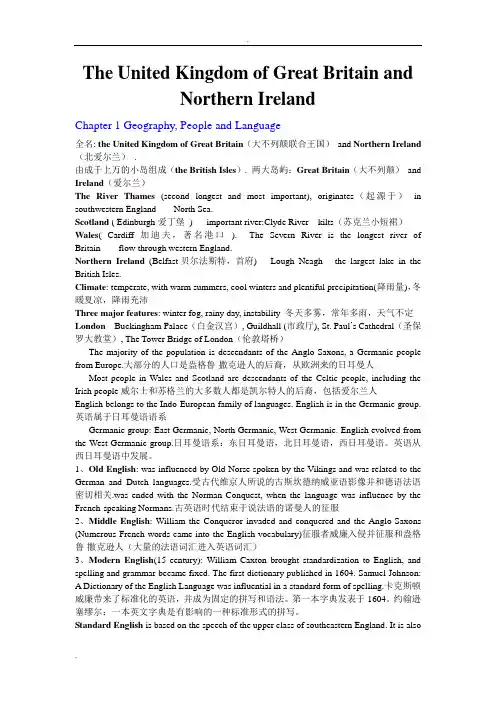
The United Kingdom of Great Britain andNorthern IrelandChapter 1 Geography, People and Language全名: the United Kingdom of Great Britain(大不列颠联合王国)and Northern Ireland (北爱尔兰).由成千上万的小岛组成(the British Isles). 两大岛屿:Great Britain(大不列颠)and Ireland(爱尔兰)The River Thames(second longest and most important), originates(起源于)in southwestern England -----North Sea.Scotland ( Edinburgh爱丁堡) important river:Clyde River kilts(苏克兰小短裙)Wales( Cardiff加迪夫,著名港口). The Severn River is the longest river of Britain------flow through western England.Northern Ireland(Belfast贝尔法斯特,首府) Lough Neagh----the largest lake in the British Isles.Climate: temperate, with warm summers, cool winters and plentiful precipitation(降雨量),冬暖夏凉,降雨充沛Three major features: winter fog, rainy day, instability 冬天多雾,常年多雨,天气不定London---Buckingham Palace(白金汉宫), Guildhall (市政厅), St. Paul’s Cathedral(圣保罗大教堂), The Tower Bridge of London(伦敦塔桥)The majority of the population is descendants of the Anglo-Saxons, a Germanic people from Europe.大部分的人口是盎格鲁-撒克逊人的后裔,从欧洲来的日耳曼人Most people in Wales and Scotland are descendants of the Celtic people, including the Irish people威尔士和苏格兰的大多数人都是凯尔特人的后裔,包括爱尔兰人English belongs to the Indo-European family of languages. English is in the Germanic group.英语属于日耳曼语语系Germanic group: East Germanic, North Germanic, West Germanic. English evolved from the West Germanic group.日耳曼语系:东日耳曼语,北日耳曼语,西日耳曼语。
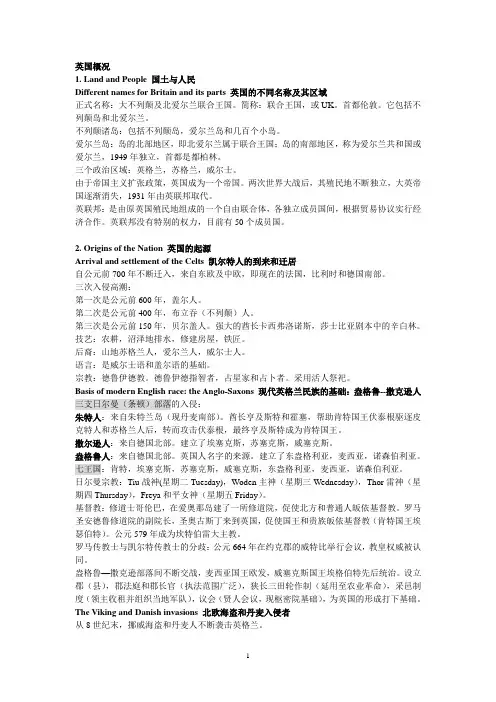
英国概况1. Land and People 国土与人民Different names for Britain and its parts 英国的不同名称及其区域正式名称:大不列颠及北爱尔兰联合王国。
简称:联合王国,或UK。
首都伦敦。
它包括不列颠岛和北爱尔兰。
不列颠诸岛:包括不列颠岛,爱尔兰岛和几百个小岛。
爱尔兰岛:岛的北部地区,即北爱尔兰属于联合王国;岛的南部地区,称为爱尔兰共和国或爱尔兰,1949年独立,首都是都柏林。
三个政治区域:英格兰,苏格兰,威尔士。
由于帝国主义扩张政策,英国成为一个帝国。
两次世界大战后,其殖民地不断独立,大英帝国逐渐消失,1931年由英联邦取代。
英联邦:是由原英国殖民地组成的一个自由联合体,各独立成员国间,根据贸易协议实行经济合作。
英联邦没有特别的权力,目前有50个成员国。
2. Origins of the Nation 英国的起源Arrival and settlement of the Celts 凯尔特人的到来和迁居自公元前700年不断迁入,来自东欧及中欧,即现在的法国,比利时和德国南部。
三次入侵高潮:第一次是公元前600年,盖尔人。
第二次是公元前400年,布立吞(不列颠)人。
第三次是公元前150年,贝尔盖人。
强大的酋长卡西弗洛诺斯,莎士比亚剧本中的辛白林。
技艺:农耕,沼泽地排水,修建房屋,铁匠。
后裔:山地苏格兰人,爱尔兰人,威尔士人。
语言:是威尔士语和盖尔语的基础。
宗教:德鲁伊德教。
德鲁伊德指智者,占星家和占卜者。
采用活人祭祀。
Basis of modern English race: the Anglo-Saxons 现代英格兰民族的基础:盎格鲁--撒克逊人三支日尔曼(条顿)部落的入侵:朱特人:来自朱特兰岛(现丹麦南部)。
酋长亨及斯特和霍塞,帮助肯特国王伏泰根驱逐皮克特人和苏格兰人后,转而攻击伏泰根,最终亨及斯特成为肯特国王。
撒尔逊人:来自德国北部。
建立了埃塞克斯,苏塞克斯,威塞克斯。
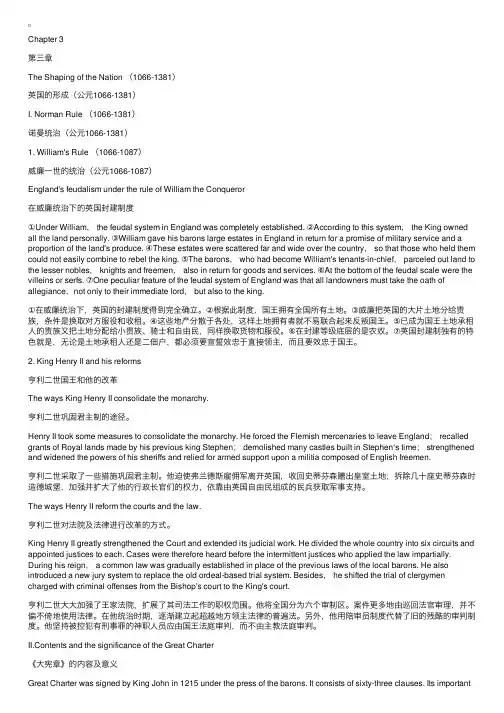
Chapter 3第三章The Shaping of the Nation (1066-1381)英国的形成(公元1066-1381)I. Norman Rule (1066-1381)诺曼统治(公元1066-1381)1. William's Rule (1066-1087)威廉⼀世的统治(公元1066-1087)England's feudalism under the rule of William the Conqueror在威廉统治下的英国封建制度①Under William, the feudal system in England was completely established. ②According to this system, the King owned all the land personally. ③William gave his barons large estates in England in return for a promise of military service and a proportion of the land's produce. ④These estates were scattered far and wide over the country, so that those who held them could not easily combine to rebel the king. ⑤The barons, who had become William's tenants-in-chief, parceled out land to the lesser nobles, knights and freemen, also in return for goods and services. ⑥At the bottom of the feudal scale were the villeins or serfs. ⑦One peculiar feature of the feudal system of England was that all landowners must take the oath of allegiance,not only to their immediate lord, but also to the king.①在威廉统治下,英国的封建制度得到完全确⽴。
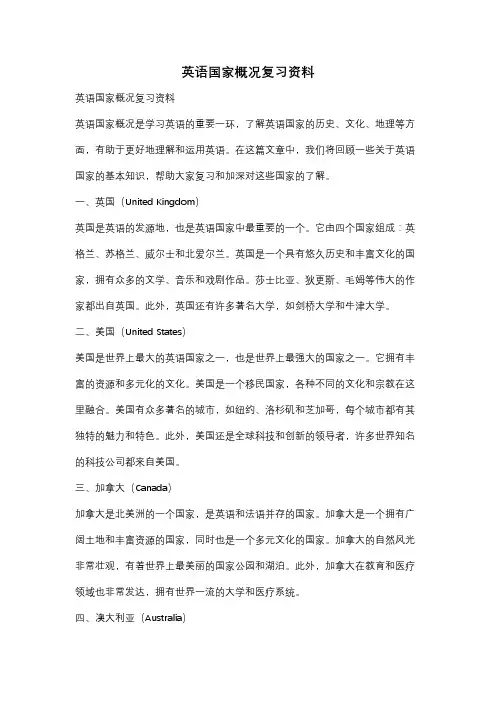
英语国家概况复习资料英语国家概况复习资料英语国家概况是学习英语的重要一环,了解英语国家的历史、文化、地理等方面,有助于更好地理解和运用英语。
在这篇文章中,我们将回顾一些关于英语国家的基本知识,帮助大家复习和加深对这些国家的了解。
一、英国(United Kingdom)英国是英语的发源地,也是英语国家中最重要的一个。
它由四个国家组成:英格兰、苏格兰、威尔士和北爱尔兰。
英国是一个具有悠久历史和丰富文化的国家,拥有众多的文学、音乐和戏剧作品。
莎士比亚、狄更斯、毛姆等伟大的作家都出自英国。
此外,英国还有许多著名大学,如剑桥大学和牛津大学。
二、美国(United States)美国是世界上最大的英语国家之一,也是世界上最强大的国家之一。
它拥有丰富的资源和多元化的文化。
美国是一个移民国家,各种不同的文化和宗教在这里融合。
美国有众多著名的城市,如纽约、洛杉矶和芝加哥,每个城市都有其独特的魅力和特色。
此外,美国还是全球科技和创新的领导者,许多世界知名的科技公司都来自美国。
三、加拿大(Canada)加拿大是北美洲的一个国家,是英语和法语并存的国家。
加拿大是一个拥有广阔土地和丰富资源的国家,同时也是一个多元文化的国家。
加拿大的自然风光非常壮观,有着世界上最美丽的国家公园和湖泊。
此外,加拿大在教育和医疗领域也非常发达,拥有世界一流的大学和医疗系统。
四、澳大利亚(Australia)澳大利亚是一个位于南半球的国家,也是一个英语国家。
澳大利亚拥有宽广的土地和独特的动植物资源,是世界上最大的岛屿国家。
澳大利亚的自然环境非常独特,有着世界上最壮观的珊瑚礁和大堡礁。
此外,澳大利亚还以其高质量的教育和研究机构而闻名,吸引着来自世界各地的留学生。
五、新西兰(New Zealand)新西兰是一个位于南太平洋的岛国,也是一个英语国家。
新西兰的自然环境非常优美,有着壮丽的山脉、湖泊和海岸线。
新西兰是一个农业和旅游业发达的国家,其乳制品和葡萄酒在世界上享有盛誉。
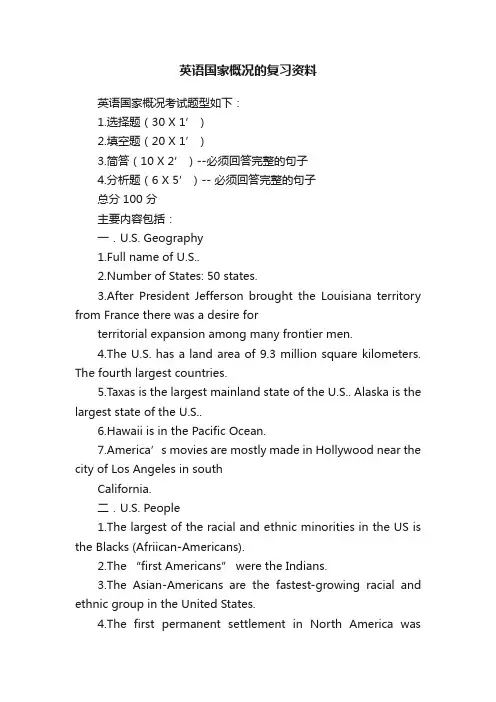
英语国家概况的复习资料英语国家概况考试题型如下:1.选择题(30 X 1’)2.填空题(20 X 1’)3.简答(10 X 2’)--必须回答完整的句子4.分析题(6 X 5’)-- 必须回答完整的句子总分100 分主要内容包括:一.U.S. Geography1.Full name of U.S..2.Number of States: 50 states.3.After President Jefferson brought the Louisiana territory from France there was a desire forterritorial expansion among many frontier men.4.The U.S. has a land area of 9.3 million square kilometers. The fourth largest countries.5.Taxas is the largest mainland state of the U.S.. Alaska is the largest state of the U.S..6.Hawaii is in the Pacific Ocean.7.America’s movies are mostly made in Hollywood near the city of Los Angeles in southCalifornia.二.U.S. People1.The largest of the racial and ethnic minorities in the US is the Blacks (Afriican-Americans).2.The “first Americans” were the Indians.3.The Asian-Americans are the fastest-growing racial and ethnic group in the United States.4.The first permanent settlement in North America wasesta blished in today’s V erginia in theyear of 1607.5.The “Three Faiths” in the U.S. refer to:ProtestanCatholicJewish6.The majority of the Catholics in the U.S. are descendants of immigrants from Ireland, Italyand Poland.7.American society is a stratified one in which power, wealth and pestige are unequallydistributed among the population.8.WASP stands for White Anglo-Saxon Protestant.三.Economy1.Services sector (industry) of the economy employs the most American.2.U.S. Federal law prohibits emplyment discrimination on the basis of:RaceLanguageDisability3.The American economy is characterized by a high degree of monoply.4.Mid-west is the nation’s leading center of heavy industry in the United States.5.Microsoft is the largest software company now in the United States.6.Give examples of industries which are decling, and industries which sare fast developing inthe U.S..( P70倒数第一行到P71 第一段)四.Policy1.When was the United States Constitution drafted?In 17872.How long are terms for Senators?6 years.3.How long are terme for members of House of Representatives?2 years4.What are the terms of office for Supreme Court justices?Life.5.Which U.S. President said: “Government of the people, by the people, for the people shall notperish from the ea rth.”---- Abraham Lincoln6.The American Constitution is the oldest written constitution in the world.7.The Declaration of Independence was adopted by the Second Continented Congress on July 4,1776.8.The United States and the People’s Republic of China established diplomatic relations in1979.9.The president of the United States is the head of the executive branch.10.Presidential election is held every 4 years in November in the U.S.A..11.What are the two major political parties in the United States? And their symbols? (P59)One is the Democtatic Party. Symbol is donkey.The other one is the Republican Party. Symbol is elephant.12.What does “FBI” stand for?Federal Bureau of Investigation.13.Who were the two famous leaders assassinated in American History?They are J.F. Kennedy and Abraham Lincoln.14.Wat are some of the major powers of each of the three branches of the U.S. government? Howare the three branches supposed to check and balance each other? (这题没有统一答案,请大家参考书本P55-P58里面的内容自己组织。
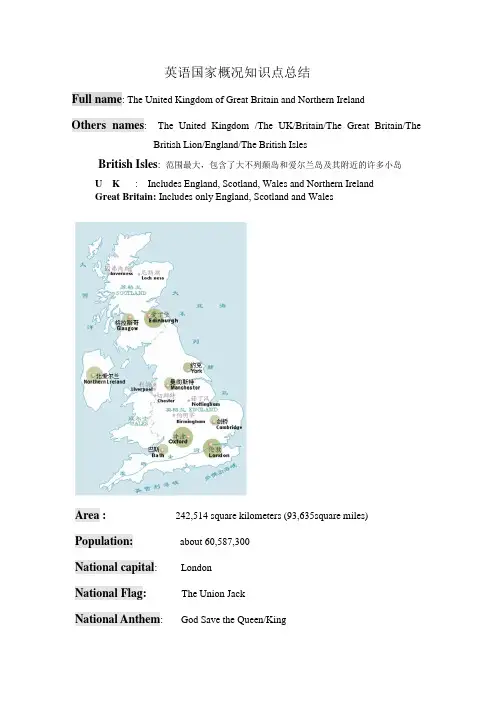
英语国家概况知识点总结Full name: The United Kingdom of Great Britain and Northern IrelandOthers names: The United Kingdom /The UK/Britain/The Great Britain/The British Lion/England/The British IslesBritish Isles: 范围最大,包含了大不列颠岛和爱尔兰岛及其附近的许多小岛U K : Includes England, Scotland, Wales and Northern IrelandGreat Britain: Includes only England, Scotland and WalesArea : 242,514 square kilometers (93,635square miles) Population: about 60,587,300National capital: LondonNational Flag: The Union JackNational Anthem: God Save the Queen/KingComponents:England:1.The largest and the most populated country of UK. It occupies more thanhalf the island of Great Britain.2.Area: 130,281 square kilometers (53.7 percent)3. Population: 50,762,900(83.8 percent) 401 people per square kilo4. Capital: London (the seat of government, center of business, the heart of artsand culture, dominates England just like England dominates TheUK)Scotland:1.The second largest of the four nations both in area and population .no longerhas a separate legislature and executive, and its economy is integrated intothat of the rest of Britain. But it does have a separate administration,different legal and educational systems as well as its Presbyterian nationalchurch. Above all it has retained much of its distinct cultural identity.2.area: 77,925 square kilometers(32.1 percent)3.population: 5,116,900 (8.4persent) 65 people per square kilo4.capital: Edinburgh (on the east cost represent the capital of theregion)5.the l argest city is Glasgow (In the west)Wales:1. A peninsular jutting from England into the Irish Sea, and is the smallestamong the three nations on the island of Britain. And has been dominated byEngland for longer period than the other three nations since its officiallyunion with England in 1536(actually England has ruled Wales in 1343 butnot officially recognized)2.area: 20732 square kilometers (8.5percent)3.population: 2,965,900(4.9persent) 142 people per square kilo4.capital: Cardiff (southern Wales) serving as an important seaport andindustrial center5.Wales retained a unique cultural social and economic development,notably its national language, Welsh, and a devolved Welsh Assembly Northern Ireland:1.Often referred to as the province of Ulster, is part of the island Ireland locatedin its northeast corner. And is the smallest both in area and population among the four nations of the UK.2.area: 13,576square kilometers (5.7 percent of the UK and one six of the islandof Ireland )3.population:1,741,600(2.9 percent)4.capital:Belfast (a seaport on the east cost , is a center of shipbuilding andlinen textiles and it created the Titanic)5.。
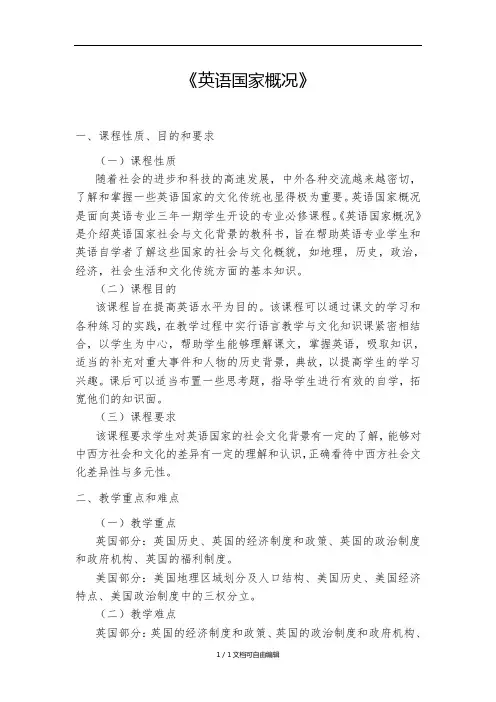
《英语国家概况》一、课程性质、目的和要求(一)课程性质随着社会的进步和科技的高速发展,中外各种交流越来越密切,了解和掌握一些英语国家的文化传统也显得极为重要。
英语国家概况是面向英语专业三年一期学生开设的专业必修课程。
《英语国家概况》是介绍英语国家社会与文化背景的教科书,旨在帮助英语专业学生和英语自学者了解这些国家的社会与文化概貌,如地理,历史,政治,经济,社会生活和文化传统方面的基本知识。
(二)课程目的该课程旨在提高英语水平为目的。
该课程可以通过课文的学习和各种练习的实践,在教学过程中实行语言教学与文化知识课紧密相结合,以学生为中心,帮助学生能够理解课文,掌握英语,吸取知识,适当的补充对重大事件和人物的历史背景,典故,以提高学生的学习兴趣。
课后可以适当布置一些思考题,指导学生进行有效的自学,拓宽他们的知识面。
(三)课程要求该课程要求学生对英语国家的社会文化背景有一定的了解,能够对中西方社会和文化的差异有一定的理解和认识,正确看待中西方社会文化差异性与多元性。
二、教学重点和难点(一)教学重点英国部分:英国历史、英国的经济制度和政策、英国的政治制度和政府机构、英国的福利制度。
美国部分:美国地理区域划分及人口结构、美国历史、美国经济特点、美国政治制度中的三权分立。
(二)教学难点英国部分:英国的经济制度和政策、英国的政治制度和政府机构、英国的福利制度。
美国部分:美国地理区域划分及人口结构、美国经济特点、美国政治制度中的三权分立。
三、教学内容第一章英国第一课:英国的国土和人民教学内容:英国的地理特征,四部分的山水河流,气候状况,英国的各个民族。
这一部分主要从整体对大不列颠及北爱尔兰联合王国作一个综述。
了解英国不同名称的含义,英国的地理特征、河流和湖泊、气候的特点以及影响气候的因素,了解英国的民族构成、人口结构及其特点;了解英国的语言构成及阶级状况。
第二课:英国历史教学内容:英国的起源(1066年诺曼征服之前的历史,即英国早期遭受的三次外族入侵):诺曼王朝,金雀花王朝,兰开斯特王朝,约克王朝,都铎王朝,斯图亚特王朝,克伦威尔时期的共和国,复辟时期,光荣革命,工业革命,宪章运动,英帝国的殖民扩张,一战及二战中的英国,战后到八十年代末的英国。
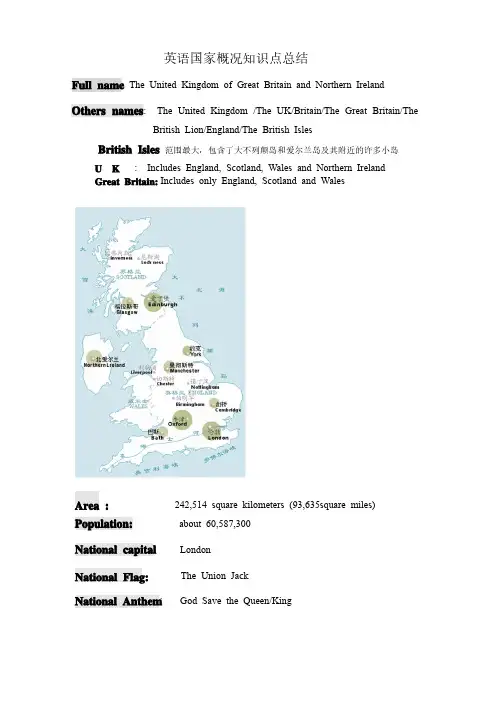
英语国家概况知识点总结Full name: The United Kingdom of Great Britain and Northern Ireland Others names : The The United United United Kingdom Kingdom Kingdom /The /The /The UK/Britain/The UK/Britain/The UK/Britain/The Great Great Great Britain/The Britain/The British Lion/England/The British Isles British Isles: 范围最大,包含了大不列颠岛和爱尔兰岛及其附近的许多小岛U K : Includes England, Scotland, Wales and Northern Ireland Great Britain: Includes only England, Scotland and Wales Includes only England, Scotland and Wales Area :242,514 square kilometers (93,635square miles) Population:about 60,587,300National capital: : London National Flag: The Union Jack National Anthem: God Save the Queen/King Components : England: 1. The The largest largest largest and and and the the the most most most populated populated populated country country country of of of UK. UK. UK. It It It occupies occupies occupies more more more than than half the island of Great Britain. 2. Area : 130,281 square kilometers (53.7 percent) 3. Population : 50,762,900(83.8 percent) 401 people per square kilo 4. Capital : London (the seat of government, center of business, the heart of arts and and culture, culture, culture, dominates dominates dominates England England England just just just like like like England England England dominates dominates dominates The The UK) Scotland: 1. The second largest of the four nations both in area and population .no longer has a separate legislature and executive, and its economy is integrated into that that of of of the the the rest rest rest of of of Britain. Britain. Britain. But But But it it it does does does have have have a a a separate separate separate administration, administration, different different legal legal legal and educational and educational systems systems as well as well as as its Presbyterian national its Presbyterian national church. Above all it has retained much of its distinct cultural identity. 2. area: 77,925 square kilometers(32.1 percent) 3. population : 5,116,900 (8.4persent) 65 people per square kilo 4. capital : Edinburgh (on the east cost represent the capital of the region) 5. the l a rgest argest city is Glasgow (In the west) Wales: 1. A A peninsular peninsular peninsular jutting jutting jutting from from from England England England into into into the the the Irish Irish Irish Sea, Sea, Sea, and and and is is is the the the smallest smallest among the three nations on the island of Britain. And has been dominated by England England for for for longer longer longer period period period than than than the the the other other other three three three nations nations nations since since since its its its officially officially union with England in 1536(actually England has ruled Wales in 1343 but not officially recognized) 2. area: 20732 square kilometers (8.5percent) 3. population: 2,965,900(4.9persent) 142 people per square kilo 4. capital: Cardiff (southern Wales) serving as an important seaport and industrial center 5. Wales retained a unique cultural social and economic development, notably its national language, Welsh, and a devolved Welsh Assembly Northern Ireland: 1. Often referred to as the province of Ulster, is part of the island Ireland located in its northeast corner. And is the smallest both in area and population among the four nations of the UK. 2. area : 13,576square kilometers (5.7 percent of the UK and one six of the island of Ireland ) 3. population :1,741,600(2.9 percent )4. capital: Belfast Belfast (a (a (a seaport seaport seaport on on on the the the east east east cost cost cost , , , is is is a a a center center center of of of shipbuilding shipbuilding shipbuilding and and linen textiles and it created the Titanic) 5.。
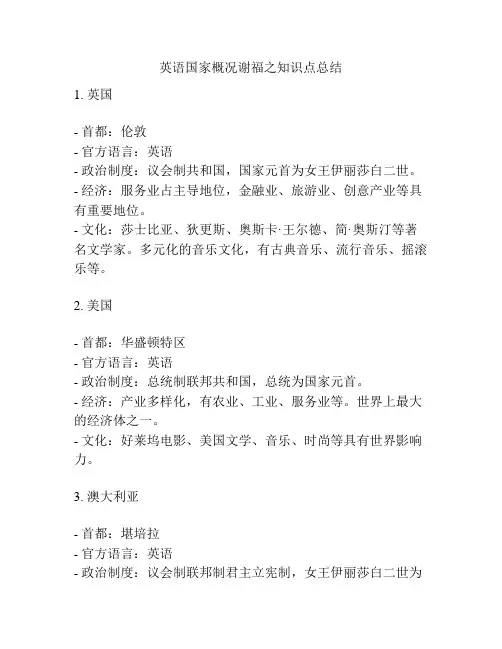
英语国家概况谢福之知识点总结1. 英国- 首都:伦敦- 官方语言:英语- 政治制度:议会制共和国,国家元首为女王伊丽莎白二世。
- 经济:服务业占主导地位,金融业、旅游业、创意产业等具有重要地位。
- 文化:莎士比亚、狄更斯、奥斯卡·王尔德、简·奥斯汀等著名文学家。
多元化的音乐文化,有古典音乐、流行音乐、摇滚乐等。
2. 美国- 首都:华盛顿特区- 官方语言:英语- 政治制度:总统制联邦共和国,总统为国家元首。
- 经济:产业多样化,有农业、工业、服务业等。
世界上最大的经济体之一。
- 文化:好莱坞电影、美国文学、音乐、时尚等具有世界影响力。
3. 澳大利亚- 首都:堪培拉- 官方语言:英语- 政治制度:议会制联邦制君主立宪制,女王伊丽莎白二世为国家元首。
- 经济:服务业是主要产业,同时还有矿业、农业、制造业等。
- 文化:澳大利亚文学、电影、音乐、美食等具有独特风格。
4. 加拿大- 首都:渥太华- 官方语言:英语、法语- 政治制度:议会制联邦制君主立宪制,女王伊丽莎白二世为国家元首。
- 经济:移民国家,有制造业、自然资源开发、服务业等产业。
- 文化:加拿大文学、电影、音乐、美食等具有多元化和包容性。
5. 新西兰- 首都:惠灵顿- 官方语言:英语、毛利语- 政治制度:议会制君主立宪制,女王伊丽莎白二世为国家元首。
- 经济:服务业占主导地位,同时还有农业、林业、制造业等产业。
- 文化:毛利文化、新西兰电影、音乐、户外活动等具有独特特色。
What are the differences between Britain and the British Isles, Great Britain, England, the United Kingdom and the British Commonwealth?~The British Isles, Great Britain and England are geographical names, not the official names of the country, while the official name is the United Kingdom, but the full name is the United Kingdom of Great Britain and Northern Ireland. The British Commonwealth is a free association of independent countries that were once colonies of Britain. Describe the geographical position of Britain.~Britain is an island country. It lies in the north Atlantic Ocean off the north coast of Europe. It is separated from the rest of Europe by the English Channel in the south and the North Sea in the east. Whereabouts in Great Britain are mostly highland and lowland?~The north and west of Britain are mainly highland, while the east and southeast are mostly lowlands.Does Britain have a favourable climate? Why? Yes, it bas a favourable climate. Because it has a maritime type of climate—winter is mild, not too cold, and summer is cool, not too hot. It has a steady reliable rainfall throughout the whole year. It has a small range of temperature, too. What are the factors which influence the climate in Britain? Which part of Britain has the most rainfall and which part is the driest?~The factors which influence the climate in Britain are the following three: (1) The surroundingwaters balance the seasonaldifferences by heating upthe land in winter andcooling it off in summer; (2)The prevailing southwestwinds bring warm and wetair in winter and keep thetemperatures moderate; (3)The North Atlantic Drift, awarm current, passes thewestern coast of the BritishIsles and warms them.The northwestern parthas the most rainfall, whilethe southeastern corner isthe driest.Describe the distributionof Britain’s population.~Britain has a population ofabout 57 million. It isdensely populated, with anaverage of 237 people persquare kilometer. It is alsovery unevenly distributed,with 90% of the populationin urban areas, 10% in ruralareas. Geographically, mostBritish people live inEngland. Of the total of 57million people, 47 millionlive in England, 14millionlive in London andsoutheastern England.What are the threenatural zones in Scotland?~The three natural zones inScotland are: the Highlandsin the north, the centralLowlands and the southernuplands.What is the differencebetween the ancestors ofthe English and Scots,Welsh and Irish?~The ancestors of theEnglish are Anglo-Saxons,while the Scots, Welsh andIrish are Celts.What are the differencesin character and wpeechbetween southernEngland and northernEngland? How do theWelsh keep their languageand culture alive?~The English have manydifferences in regionalspeech. The chief divisionis between southernEngland and northernEngland. Generallyspeaking southerners speakthe type of English closer toBBC English. They do nothave a special accentexcept the Cockneys fromthe East End of London.However, the northernerspeak broader English thansoutherners, and often leaveout the article “the” and thepossessive adjectives “my”,“your”, “their”, etc.The Welsh areemotional and cheerfulpeople, They are musiclovers and are proud oftheir past. Throughout theyear thy hold competitionsin Welsh poetry, music,singing and art, and in thisway they keep the WelshLanguage and Welshculture alive.What is the main problemin Northern Ireland?~Hundreds of years agoScots and EnglishProtestants were sent to livein Northern Ireland. Sincethen there has been bitterfighting between theProtestants and the RomanCatholics. The former arethe dominant group, whilethe latter are seeking moresocial, political andeconomic opportunities.The British Governmentand Government of Irelandare now working togetherto bring peace to NorthernIreland.What do you know aboutthe Roman invasion ofBritain?~In 55BC and 54BC, JuliusCaesar, a Roman general,invaded Britain twice. InAD 43, the EmperorClaudius invaded Britainsuccessfully. For nearly 400years Britain was under theRoman occupation, thoughit was never a totaloccupation. Britishrecorded history beginswith the Roman invasion.Why was the Romaninfluence on Britain solimited?~Britain was under theRoman occupation fornearly 400 years. TheRoman built many towns,roads, temples andbuildings. They alsobrought the new religion,Christianity to Britain.However,although Britainbecame part of the RomanEmpire, Roman influenceupon Britons was verylimited. The Roman treatedthe Britons as a subjectpeople of slave class. Theynever intermarried. TheRomans had no influenceon the language or cultureof ordinary Britons.Who were theAnglo-Saxons and howdid the heptarchy comeinto being?~The Anglo-Saxonsreferred to the threeTeutonic tribes whoinvaded Britain in themid-5th century. They wereJutes, Saxons and Angles.In the 7th century, theAnglo-Saxons invadedBritain and three tribessettled in different parts ofBritain which was dividedin many small kingdoms.Among them, there wereseven principal kingdomsof Kent, Essex, Sussex,Wessex, East Anglia,Mercia and Northumbriahave been given the nameof Heptachy.How were the earlyAnglo-saxons convertedto Christianity?~The Anglo-Saxonsbrought their own Teutonicreligion to Britain whenthey invaded Britain, andChristianity was only afringe belief. So, in 579,Pope Gregory I sent StAugustine to England toconvert the heathen Englishto Christianity. Augustinewas very successful inconverting the king and thenobility, and became thefirst Archbishop ofCanterbury. But theconversion of the commonpeople was largely due tothe missionary activities ofthe monks in the north.Many small monasteriessprang up throughout thecountry.What contributions didthe early Anglo-Saxonsmake to the English state?~Though the Anglo-Saxonswere brutal people, theylaid the foundations of theEnglish state. Firstly, themodern names of“England”and “English”derived from the Angles.Secondly, they divided thecountry into shires, withshire courts and shirereeves, or sheriffs,responsible foradministering law. Thirdly,they devised thenarrow-strip, three-fieldfarming system whichcontinued to the 18thcentury. Fourthly, they alsoestablished the manorialsystem, whereby the lord ofthe manor collected taxesand organized the localarmy. Finally, they createdthe Witan to advise the king,the basis of the PrivyCouncil which still existstoday.Who were Vikings andhow did thry invadeBritain?~The Vikings were theNorwegians and the Danesfrom Denmark. Theyattacked various partsofEngland from the end of the8th century. They became aserious problem in the 9th century, especially between 835 and 878. they even managed to capture York, an important center of Christianity in867. they gained control of the north and east of England(“the Danelaw”).What do you know about King Alfred? What makes him worthy of the title of “Alfred the Great”?~Alfred was the king of Wessex. He defeated the Danes who attacked England and reached an agreement with them in 879. The Danes gained control of the north and east, while Alfred ruled the rest. He also converted some leading Danes into Christians.Alfred is known as “the father of the British navy”as he founded a strong fleet to beat the Danes at sea, to protect the coasts and to encourage trade. He reorganized the Saxon army to make it more efficient. He even translated Bede’s “Ecclesiastical History of the English People”from Latin to English. He also established schools and formulated a legal system. All this made him worthy of his title “Alfred the Great”.Why did the William the Conqueror invade England after Edward’s death?~It was said that King Edward had promised the English throne to William but the Witan chose Harold as king. So William led his army to invade England. In October 1066, during the important battle of Hastings, William defeated Harold and killed him. On Christmas Day, William was crowned king ofEngland, thus beginning theNorman Conquest ofEngland.What were theconsequences of theNorman Conquest?~The Norman Conquest of1066 is one of the bestknown events in Englishhistory. It brought aboutmany consequences.William confiscatedalmost all the land and gaveit to his Norman followers.He replaced the weakSaxon rule with a strongNorman government. Sothe feudal system wascompletely established inEngland. Relations with theContinent were opened, andcivilization and commercewere extended.Norman-French culture,language, manners, andarchitecture were beenintroduced. The church wasbrought into closerconnection with Rome, andthe church courts wereseparated from the civilcourts.Why do we say that theEnglish nation is amixture of nationalities ofdifferent origins?~The population of Britainis made up of the English,the Scottish, the Welsh, theIrish, the Northern Irish andother peoples. Theformation is complicatedbecause England wasinvaded by different racesat various times fromEurope.Besides the earlysettlers, the Iberians and theCelts, including Gaels andBritons, Roman occupiedBritain for nearly 400 yearsafter 55BC. Then theinvasions of Anglo-Saxonshelped to form English raceand language and laid thefoundation of the Englishstate. After that, were theinvasions of the Vikingsand Danes. Finally, in 1066,William of Normandyinvaded England and beganthe age of the NormanConquest which resulted ingreat French influence.Therefore, manydifferent peoples ofdifferent origins are livingin Britain. That’s the reasonwhy we say English nationis a mixture of nationalitiesof different origins.What was feudalism likein England under the ruleof William theConqueror?~Under the rule of William,the Conqueror, the feudalsystem in England wascompletely established.According to this system,the king owned all the landpersonally. William gavehis barons large estates inreturn for military servicesand a proportion of theland’s produce. Theseestates were scattered allover the country so that thebarons could not easilycombine to rebel the king.Then, the barons parceledout land to the lesser nobles,knights and freemen, alsoin return for goods andservices. At the bottom ofthe feudal scale were theserfs. One peculiar featureof the feudal system ofEngland was that alllandowners must take theoath of allegiance not onlyto their immediate lord, butalso to the king.How did King Henry IIconsolidate monarchy?~Henry II took somemeasures to consolidate themonarchy. He forced theFlemish mercenaries toleave England; recalledgrants of Royal lands madeby Stephen; demolishedscores of castles built inStephen’s time;strengthened and widenedthe powers of his sheriffsand relied for armedsupport upon a militiacomposed of Englishfreemen.How did King Henry IIreform the courts and thelaw?~Henry II greatlystrengthened the king’scourt and extended itsjudicial work. He dividedthe country into six circuitsand appointed itinerantjustices who apply the lawimpartially.In Henry II’s reign, acommon law wasestablished which overrodelocal law and private lawand was common to thewhole people.The jury systemreplaced old Englishordeals and old Normantrials. At that time, a jurywas composed of 12 menand the jurors function wasto act as witnesses, not tohear evidences and giveverdict.As part of his legalreforms, Henry II insistedthat all clergymen chargedwith criminal offences betried in the king’s courtinstead of in the Bishop’scourts.What was the quarrelbetween King Henry IIand Thomas Becket?~As part of his legalreforms, Henry II wished toreform certain abuses inchurch government andinsisted that all。
2011年英语国家概况复习提纲(2010级1、2、3、4班)一、考试题型1、选择题(10%):10个小题,每题1分。
2、判断正误题(10%):10个小题,每题1分。
3、术语翻译(英译汉10%):10术语,每个术语1分。
4、名词解释(20%):5个术语,每个4分。
5、简答题(30%):6个小题,每题5分。
6、论述题(20%):1个小题。
二、考试范围美国部分全部10章,英国部分前4章(第一至第四章)、2000年——2010年八级考试中关于英语国家概况试题。
三、考试依据教材、课件PPT、历年八级考试中关于英语国家概况试题四、考试重点1、重点翻译术语:(1) New Frontier 新边疆(2) the Civil Rights Movement 民权运动(3) the Great Society 伟大社会(4) the Counterculture Movement 反主流文化运动(5) the New Left Movement 新左派运动(6) the Anti-War Movement 反战运动(7) the Strategic Defence Initiative 战略防御措施(8) the Populist Party人民党(9) Star Wars星球大战(10) Monroe Doctrine门罗主义(11) Truman Doctrine 杜鲁门主义(12) the Marshall Plan 马歇尔计划(13) the Missile Crisis 导弹危机(14) the House Un-American Activities Committee 众议院非美活动调查委员会(15) WASP 白人盎格鲁—撒克逊新教徒(16) indentured servants 契约佣工(17) the Civil War 美国内战(18) the National Association for the Advancement of Colored People 全国有色人种协进会(19) model minority 模范少数族裔(20) Indian Reservations 印第安人保留区(21) Gold Rush淘金热(22) Supreme Court最高法院(23) the Court of Appeals 上诉法院(24) the District Court地区法庭(25) judicial review 司法复审(26) the House of Representatives 众议院(27) chief justice 首席大法官(28) associate justice 大法官(29) the Articles of Confederation 《邦联条例》(30) winner-take-all 赢者通吃/ (美国总统选举中)胜者获得所有选举人选票(31) grants-in-aid programs联邦拨款项目(32) the midterm election中期选举(33) Watergate Scandal水门事件丑闻(34) Electoral College选举人团(35) laissez faire自由放任(36) post-industrial society后工业社会(37) Sherman Antitrust Act谢尔曼反托拉斯法(38) New Deal新政(39) National Labor Relations Board全国劳工关系委员会(40) Social Security system 社会保障制度(41) Food Stamp食物劵(42) Aid to Families with Dependent Children未成年人家庭援助计划(43) original jurisdiction 初审管辖权(44) grand jury 大陪审团(45) petit jury 小陪审团(46) the Department of Justice 司法部(47) the Attorney General 司法部长/ 总检察长(48) the Solicitor General 司法部副部长/副总检察长(49) Common Law 习惯法(50) civil law 民法(51) criminal law 刑法(52) the Federal Bureau of Investigation美国联邦调查局(53) due process of law 正当法律程序(54) charter school 特许公立学校(55) school voucher 教育劵(56) associate degree 准学位(57) community college 社区大学(58) the Bilingual Education Act 双语教育法(59) affirmative action program 积极行动方案(60) reverse discrimination 反向歧视(61) compulsory education 义务教育(62) city upon a hill 山巅之城(63) the Great Awakening 大觉醒运动(64) rummage sales 旧杂物义卖(65) the Grand Canyon 大峡谷(66) British Commonwealth英联邦(67) God save the King /Queen 天佑吾王(68) the Stars and Stripes星条旗(69) E pluribus unum合众为一(70) the Good Friday Agreement北爱尔兰和平协议(71) Magna Carta(英国)大宪章(72) shadow cabinet影子内阁(73) the House of Lords 贵族院/ 上议院(74) Lords Spiritual 神职贵族(75) Lords Temporal 俗职贵族(76) the House of Commons下议院(77) Constitutional Monarchy君主立宪制(78) the Prime Minister首相(79) the Department of State国务院(80) Secretary of Commerce商务部长2、重点名词解释术语(1) American Dream(2) WASP(3) judicial review(4) federalism(5) the midterm election(6) Electoral College(7) laissez faire(8) New Deal(9) Medicare(10) Medicaid(11) grand jury(12) petit jury(13) the adversary system(14) affirmative action program(15) reverse discrimination(16) Manifest Destiny(17) British Commonwealth(18) protestantism(19) Group Eight(20) the Union Flag3、简答题复习范围(共24题)1. 关于英国部分(1) What influences the climate in the UK? (Unit 1)(2) What are the key elements in “Britishness” that the citizens of the UK share? (Unit 2)(3) It is said that British history has been a history of invasions. What are the major invasions in the history? (Unit 3)(4) What are the four major characteristics of the British Constitution? (Unit 4)(5) What are the functions of Parliament? How does the law-making process? (Unit 4)2. 关于美国部分(6) Describe the four recognizable and definable topographic regions in the United States. (Unit 1)(7) What makes the Northeast stand out as a unique cultural region? (Unit 1)(8) How did the South and the North differ from each other in their economic development before the Civil War? (Unit 2)(9) From what parts of Europe did immigrants mainly come in the 17th, 18th and much of the 19th centuries? (Unit 3)(10) How is the President elected? What are the presidential election’s proceedings? (Unit 4)(答案以ppt为准)(11) What qualifications does one need in order to vote in the U.S.? (Unit 4)(12) What are the powers of the US president? (Unit 4)(13) What was Alexander Hamilton’s plan for the development of the new Republic? (Unit 5)(14) What are the main characteristics of the post-industrial society? (Unit 5)(答案以ppt为准)(15) What were the two key traditional attitudes of Americans towards social services? (Unit 6)(16) What are the main areas covered by social security in the U.S.? (Unit 6)(17) The U.S. has a three-tiered national court system. What are the three levels? (Unit 7)(18) What are the four categories of institutions in the higher education system in the United States? (Unit 8,参考答案见ppt)(19) What reforms have been made in the United States over the past several decades for its public schools? (Unit 8)(20) What are the major differences between Roman Catholicism and Protestantism? (Unit 9)[Answer for reference: Both Roman Catholicism and Protestantism are branches of Christianity. Their differences lie mainly in two aspects. First, according to Roman Catholicism, the Pope is the authority of God’s revelation, while Protestantism believes that the Bible is the only source of revelation. Second, in Roman Catholicism, there is an episcopal hierarchy, while Protestantism believes in the universal priesthood of all the believers.](21) In what ways do American parents try to instill independent spirit in their children? (Unit 10)[Answer for reference: America parents try to instill independent spirit in their children in three ways. First, they expect their children to find part-time jobs. Second, they expect their children to leave home at an earlier age than in most other countries. Third, they expect their children to contribute to or pay for things that go beyond food, clothing, and shelter when they are above a certain age.](22) Describe the symbols in the national flag of the U.S. and their respective symbolic meanings.(参见ppt的Introduction)(23) Describe the major symbols in the grand seal of the U.S. and explain their respective symbolic meanings. (参见ppt的Introduction)(24) What were the major ideas in the Declaration of Independence?[Answer for reference: The document declared that all men were equal and that they were entitled to some unalienable rights such as life, liberty and the pursuit of happiness. It also explained the philosophy of government: the power of government came from the consent of the governed and the purpose of government was to secure the rights mentioned above. The theory of politics and the guiding principles of the American Revolution mainly came from John Locke.]。
英语国家概况知识点总结概述:英语被广泛用于世界各地,特别是在英语国家。
英语国家是指以英语为官方语言的国家。
这些国家在文化、历史和政治方面有着共同的特点。
本文将总结关于英语国家的一些重要知识点。
1. 英语国家数量:目前,英语被作为官方语言或主要语言使用在75个国家和地区。
其中,英国、美国、加拿大和澳大利亚是英语国家中最重要的四个国家。
2. 英语的起源:英语起源于古代日耳曼语,并受到盎格鲁、撒克逊、日耳曼和诺曼底法语等语言的影响。
在中世纪,英语逐渐成为英格兰的主要语言,后来通过英国的殖民活动传播到世界各地。
3. 英语的变体:英语有多种变体,包括英国英语、美国英语、澳大利亚英语和加拿大英语等。
这些变体在发音、拼写和用法方面有所不同。
4. 英语国家的文化:英语国家的文化多样且富有活力。
英国是莎士比亚、达尔文和牛津剑桥等的故乡,以其丰富的文学、音乐和戏剧传统而闻名。
美国则以好莱坞电影、摇滚音乐和现代科技创新而著名。
澳大利亚和加拿大拥有美丽的自然风光,并注重多元文化的融合。
5. 英语国家的政治体制:英语国家有各种不同的政治体制。
英国是君主制国家,美国是联邦共和制国家,澳大利亚和加拿大则是联邦议会制国家。
这些国家在政治制度上有着明显的区别,但都保持着相对稳定的政治体系。
6. 英语的全球影响力:英语是联合国和其他国际组织的官方语言之一。
它也是全球商务和文化交流的主要语言。
掌握英语可以给人们提供更多的就业机会和交流平台。
7. 英语教育:英语是世界上最广泛学习的第二语言。
在许多英语国家,英语教育是义务教育的一部分。
英国、美国、加拿大和澳大利亚都有世界一流的教育体系,吸引着来自世界各地的留学生。
结论:英语国家在全球范围内有着重要的地位和影响力。
了解英语国家的概况能够帮助人们更好地理解英语语言及其文化背景。
掌握英语不仅是国际交流的必要工具,也是扩大人们视野和增加自身竞争力的关键。
Chapter 2第⼆章The Origins of a Nation (5000BC-1066)英国的起源(公元前5000年—1066年)I.Early Settlers (5000BC-55BC)早期的居民(公元前5000年—公元前55年)1.The first known settlers of Britain were the Iberians.⼈们所知的英国最早居民是伊⽐利来⼈。
2. At about 2000 BC the Beaker Folk arrived from the areas now know as Holland and Rhineland.约公元前2000年,从现在的荷兰和莱茵兰地区来了宽⼝陶器⼈。
3. The Celts began to arrive Britain about 700 BC.约公元前700年,克尔特⼈来到不列颠岛。
4. The Celts came to Britain in three main waves.克尔特⼈来到不列颠有三次⾼潮。
The first wave were the Gaels-came about 600 BC.第⼀次⾼潮是约公元前600年盖尔⼈的来临。
The second wave were the Brythons-came about 400 BC.第⼆次⾼潮是约公元前400年布⽴吞(不列颠)⼈的抵达。
The third wave were the Belgae-came about 150 BC.第三次是约公元前150年⽐利其⼈的到达。
II. Roman Britain (55BC-410AD)罗马⼈统治时期的英国(公元前55年—410年)1.British recorded history begins with the Roman invasion. In 55BC and 54BC, Julius Caesar, a Roman general,invaded Britain twice. In AD 43, the Emperor Claudius invaded Britain successfully. For nearly 400 years, Britain was under the Roman occupation, though it was never a total occupation.有记录的英国历史开始于罗马⼈的⼊侵。
5.What do you know about parliamentary reform?Political change in England did not come through revolution but through gradual reform. At the general election of 1830,the Whigs under Lord Grey returned to power and want to carry out parliamental reforms. There were several reasons.First,power was monopolized by the aristocrats.Second,representation of town and country,and North and South wasunfair.Finally,there were also various rotten or pocket boroughs.So, between 1832 and 1884 three Reform Bills were passed.The Reform Act of 1832 Abolished "rotten Boroughs",and redistributed parliamentary seats more fairly among the growing towns.lt also gave the vote to many householders and tenants ,based on the value of their property.6.What do you know about the Chartist Movement and The people's Charter? What's your comment on them?In 1836 a group of skilled workers and small shopkeepers formed the Londan Working Men's Association.they drew up a charter of political demands(a People's Charter),The Chartist movement was the first nation wide working class movement and drew attention to serious problem.Chartism failed bacause of its weak and divided leadership,and its lack of coordination with trade-unionism.7.How did the Labour Party come into being?As the new working class became established in the industrial towns in the late 18th century,they became aware of the power which they could possess if they acted together instead of separately. So various working class organizations were formed which brough about the formation of a political party, the Labour Party.The Labour Party had its origins in the Independent Labour Party,which was formed in January, 1893 and led by Keir Hardie, a Scottish miner. The foundation of an effective party for labour depended on the trade unions. In 1900,representatives of trade unions,the ILP,and a number of small societies set up the Labour Representation Committee(LRC). The IRC changed its name to the Labour Party in time for the general election which was called for in 1906.the Labour Party remains one of the two major parties in Britain until today.8.What was the colonial expansion like during the 19th century.1)In the late 18th century Britain acquired vast,underpopulatedterritories:Canada,Australia,and New Zealand.2)The conquest of India3)The scramble for Africa4)Aggression against China9.What did Winston Churchill play in the Second World War?Winston Churchill took over Chamberlain as Prime Minister in 1940 to lead Britain in such a crisis to be attacked by Germany.He received massive popular support as a war leader and led his country to final victory in 1945. He played an important role in the Second World War.10.What are the main contents of Thatcherism?Margaret Thatcher became the first woman Prime Minister in Britain in 1979.Her policies are popularly referred to as Thatcherism. It included the return to private ownership of state owned industries.the use of monetarist policies to control inflation,the weakening of trade unions,the strengthening of the role of market forces in the economy,and an emphasis on law and order.Chapter 6 The Economy1.What are the three periods as far as the evolution of the British economy is concerned?The three periods of the evolution of the British economy are:steady development in the 50s and 60s,economic recession in the 70s and economic recover in the 80s.2.What measures did the Thatcher government take to improve the nation's economy?1)Macroeconomic measures were directed towards bringing down the rate of inflation and achieving price stability.2)Microeconomic policies were aimed at working with the grain of market forces by encouraging enterprise,efficiency and flexibility(弹'性)。
英语国家概况复习资料一、The influence of the Wars of the Roses玫瑰战争的影响1、It seriously weakened the old feudal nobility.2、It further weakened the feudalism and manorialism had already declined by the beginning of the Tudor reign.3、Objectively, it was beneficial to the development of money economy and capitalism.二、the brief introduction to Constitutional Monarchy in Britain.英国君主立宪制介绍1、The British Monarchy is hereditary. The King or Queen is the head of state, the commander-in-chief of the armed forces the head of the Judicature in the UK and the temporal head of the established Church of England.2、Every act of the state is dined in the Queen’s name. Every letter sent out by government department is posted in an envelope marked “On Her Majesty’s Service”. All ministers in the government are appointed by her every official is her servant. The Queen summons, prologues and dissolves Parliament. She concludes treaties and declares war. She gives her assent to bills before they become law.3、Practically everything she does is done on the advice of her ministers, and everything has been decided by Parliament or the Prime minister in advance. The vital power lies in the Prime Minister and his Cabinet.4、Th e Queen’s real importance lies in its effect on public attitude and she is also a constant symbol for the whole nation. And she is the only legal and constitutional link binding the members of the Commonwealth to the home country.三、The brief introduction to British central government英国中央政府介绍1、The British government is the supreme administrative institution that manages state affairs.2、The Cabinet is the core of leadership of the British government. The cabinet is made up of the Prime minister, the Lord President of Privy Council and the heads of the most important departments. Every important decision is made and carried out by the Cabinet, which directs and controls the armed forces, the police the courts the prisons and others.3、The Prime Minister is the head of the central government. He or she has the duty to report the government work to the King or Queen has the right to direct all the departments and solves the issues between them. He or she has the last word in deciding the government policy. He or she has the power of appointment and reorganizing the government.4、The administrative class is responsible for advising ministers on policy, for forecasting the possible effects of new measures and regulations and for tackling any difficulties in carrying out the policies. The executive class is responsible for the daily conduct of the department’s business. The clerical class is engaged in all the usual clerical work.四、英国法院系统介绍The brief introduction to British Judicature1、The supreme judicial body in the UK is the House of Lords.2、In Britain there are central courts and local courts. Central courts include the House of Lords, Privy Council, the High Court of Justice and the Court of Appeal. The house of Lords is the civil and criminal court. The Privy Council accepts and hears appeals from the courts of member states of the British Commonwealth, colonies, protectorates and trust territories. The Court of Appealhas the right to accept appeals from the High Court of Justice. The High Court of Justice can be divided Chancellor Division dealing with the questions of company law, bankruptcy, trusts and some other matters of the same type andFamily Division tackling divorce and questions out of wills and Queen’s Bench Division handling property matters and torts as well as maritime and commercial cases.3、The civil appealing procedure: the county court, the High Court of Justice, the Courtof Appeal and the House of Lords. The criminal appealing procedure: the local court, the criminal court and the court of criminal appeal and the House of Lords.4、In Britain, there are 2 kinds of lawyers: solicitors and barristers.五、美国地理地貌特征The characteristics of geographical1、The natural landscape of the US has two fundamental dimensions,(1)one dimension results from geological processes in the earth’s crust,which determine the main patterns of landforms,drainage,and minerals,and influence the fertility of soil to a considerable degree(2)the other dimension is determined by meteorological processes in the atmosphere,which dictate the nature of weather and climate ,the geographic distribution of vegetationand soils2、(1)American’s geological topographical framework is built around a huge interior lowlandthat has yielded some of American’s greatest agriculture and mineral wealth,contains a large population.(2)This region is called “middle American”,which is drained by the Mississippi river.It is north to the wilderness bulwark of theCanadian Shield,south tothe gulf of Mexico.To the east and west,the land separate it from Atlantic and Pacific Oceans.3、In the east part,the Appalachians on the east stretch almost unbroken from Alabama tothe Canadian border and beyond.They are much-eroded old mountains and are set back fromthe Atlantic by a broad belt of coastal lowland.4、To the west of the interior basin lies the mighty system of mountains which is named “Cordillera”,which covers third of the united states,this western country is both complicated and varied,containing some of the highest mountains and a vast large expanseof intermontane basins,plateaus,and isolated ranges.5、It has impressive scenery,considerable environmental variety and great mineral wealth.六、美国独立后前25年的特征the characteristics of the first independent 25 years1、a remarkable period in American history2、by the end of the century, every state except Connecticut and Rhode Island had writtena new constitution. together,the American people had adopted a federal form of government,with the central and state governments exercising different and sometimes overlapping powers delegated to them.3、for instance,the break from England encouraged Americans to accelerate the developmentof American democratic thought and more equalitarian social attitudes.4、the break also spurred a spirit of nationalism in literature,architecture,and other aspects of American culture life5、Beyond that,the young nation also witnessed significant changes in it’s economic lifeand foreign relations in the last quarter of the 18th century七、美国内战爆发的原因The cause of the outbreak of the American civil war1、around the mid-19th century,the strong nationalistic sentiments of the first three decades of the 19th century faded away,revealing the long-hidden differences and among classes,nationalities,and sections.2、the North and the south now saw their respective economic interests often in conflictwith each other.3、on the slavery issue,they were frequently in conflict with their border-state neighbors in Kentucky and Missouri.八、对美国总统介绍(1)The President of The United States is elected every four years to a four-year term of office,with no more than two full terms allowed.(2)The President is elected directly by the voters.Whatever the case,any policies proposed by the President must be approved by the House of Representative and the Senate before they can become law.(3)The head of each department is appointed by the President.Theseappointments,however,must be approved by the Senate.None of these Secretaries,as the department heads are usually called,can also be serving in Congress or in another part of the government.Each is directly responsible to President and only serves as long as the President wants him or her to.九、介绍美国法院系统(the US Constitution)Introduce the U.S. court system1、The US Constitution only vaguely defines the organization of the court system,calling simply for a Supreme Court,with inferior courts to be created by Congress.2、The current national court structure in the United States,from bottom to top,includes district courts,courts of appeals,and one Supreme Court.3、there are currently ninety-four district courts.There may be one or more judges at each district court.All district judges hold office for life,though they can be impeached.4、If a case is successfully appealed,it will normally go to a US Court of Appeals have eleven judicial circuits in the country.5、The top of the hierarchy,is the Supreme Court,whose jurisdiction is both original and appellate.6、Most states have a hierarchical system as well, ranging from lower courts to a state supreme court。
Chapter 6 1.Soon after the Seconder World War, Brtain not only gave up its economic hegemony but also suffered a deep loss of its position of industrial leadership. Its per capita GDP had been overtaken by the United States in 1900, by France and West Germany in 1950 and by Italy in 1960.
2.Britain has been running balance of payments deficits for many decades. Britain is no longer able to match the growth rates of other industrialized countries. The term "British disease" is now often used to characterise Britain's economic decline.
3.Steady development in the 50s and 60s. With help from the United States the British economy quickly recovered. By the end of 1947 the British economy had returned to its pre-war levels. The British economy in this period : slow but steady growth, low unemployment, great material prosperity with rising standards of consumption. The theory fo John M. Keynes. High consumption and low investment.
4.Economic recession in the 70s. The end of 1973 witnessed the first oil shock. In some years of the period Britain even had minus growth and the trade deficits were the highest among the Western countries.
5.Economic recovery in the 80s. Privatization, deregulation, market liberalization. By 1988 the recovery had lasted seven years. In 1980s Britain became a net exporter of oil.
6.Just as the 1940s decade is remembered in Britain as the era of nationalization, the 1980s will be remembered as the decade of privatization, During the past decade almost 40% of the British state enterprises were privatized. 7.The Thatcher programme was successful to some extent. Mrs Thatcher tried to cure the "British disease" by applying monetarism and encouraging the market-directed economy but she failed.
8.Almost all the industrial areas in Britain except London and Belfast are based on coalfields. The output of coal reached its peak just before the First World War when 286 million tons were mined, since then the number of miners, collieries and the total output have fallen.
9.Most of which are thought to be under the North Sea. Britain is not only self-sufficient in oil but also has a surplus for export.
10.Rich deposits of iron ore were found in central England. Today the original advantages of the locations of many steelworks in Britain have gone. Local supplies have become exhausted and although new discoveries of ore have been found in Britain. Ore must be imported from Spain, Sweden and elsewhere.
11.Britain's steelworks are not efficient. 12.The main textile producing regions of Britain are now the East Midlands, Yorkshire and Humberside, and Northern Ireland. The cotton textile industry lies in Lancashire west of the wool-weaving cities, because on the west side of the Pennine Mountains, the climate is humid and the damp air makes it possible to spin cotton without breaking it.
13.The reasons behind the decline can be summarized generally as follows(以下5点) 14.There are three areas in Britain which have seen some high-tech industrial growth: the area between London and South Wales, the Cambridge area of East Anglia and the area between Glasgow and Edinburgh in Scotland. Scotland has Europe's largest collection of foreign-woned chip factories.
15.Farming is one of Britain's most important industries. It is the source of most of the food and many of the raw materials of the country. It is highly mechanized. In Britain only 3% of the population are farmers but they manage 70% of th land area.
16.Very modern farmers use computers today. They talk about technological farming. The new farming has been called "agribusiness", because it is equipped and managed like an industrial business with a set of inputs into the farm. The emphasis is upon intensive farming, designed to give the maximum output of crops and animals.
17.There are mainly six farming types in Britain. They are arable farming, dairy farming, stock farming, mixed farming, hill farming and market gardening.
18.Arable farming: The chief areas are in the East and South-East. The chief crops are wheat, barley, oats, sugar beet and potatoes. Wheat in the form of bread is the staple food of the British. Potatoes are another staple food of the British.
19.Dairy farming: andy area with important transport near a large town may become a dairy region
20. Stock farming: It is the chief kind of farming in the North and West of Britain where the climate and physical features are not fit for crops.